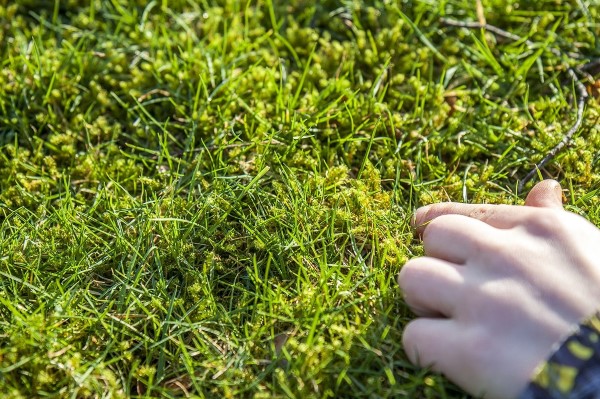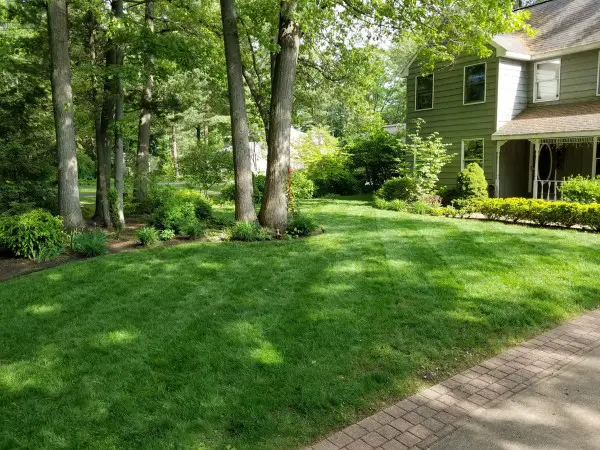If you water your lawn frequently and there are also some shady spots that don’t get much direct sunlight, then the appearance of moss is really inevitable. Today, more and more gardeners are choosing to ditch their high-maintenance grass lawn and replace it entirely with moss, micro-clover, or some other ground-covering plant species. However, if you still care about your English lawn and really want it to look perfect, then today’s article is for you. Here we give you tips and tricks on how to remove moss from your lawn without using aggressive chemical herbicides. Instead, we will show you how easy it is to achieve good results with common home remedies and timely prevention.
Moss looks magical in the woods, but he has no place in the lawn


Myths and truths about moss destruction in lawns
We keep reading about home remedies that are supposed to drive moss out of the lawn. Salt, vinegar, baking soda and washing soda, Coca-Cola, even stain removers and bleach are sometimes used. With targeted use, the moss actually dies within a few hours or days, but so does the grass all around. This treatment often leaves behind even uglier, bare and yellow-brown patches in the lawn.
Some of these home remedies are quite good for cleaning garden furniture, sidewalks, patios, terraces, house facades, even roofs. In the garden, however, they do as much harm as good, so they have no business there.
The use of vinegar and table salt in the garden and on sealed surfaces is now even banned in many regions of Germany. With these home remedies, not only are all plants killed, the soil also remains infertile for several years!
Home remedies that kill weeds also kill ornamental plants

Salt and vinegar prefer to stay in the kitchen

Remove moss in the lawn with effective methods
Targeted attacks on moss and other weeds do not bring lasting results. On top of that, they leave unsightly bare spots in the lawn. Only after a few weeks does the creeping plant appear again, because the living conditions remain the same. Moss doesn’t need much to grow and thrive. All it needs is some shade, moist and nutrient-poor soil with poor drainage.
In order not only to remove the moss from the lawn, but also to prevent it from forming again, the causes of the first appearance must be tackled bit by bit. If you make the lawn grass healthy again, you can also suppress weeds yourself.
Prevention is the best medicine

The shade
Some gardens are simply more shady than others for a variety of reasons. Whether it’s through the crown of a large tree or the facade of a building, shadow is sometimes inevitable. Lawn grass is generally a very light-hungry plant. However, nowadays there is not a single type of lawn grass that you can plant.
There are numerous types and varieties available at hardware stores and garden centers that can withstand different conditions. For shade, it is best to buy a special shade lawn mixture. In particular, meadow grass (Poa supina) should be present in it, because this is particularly competitive with moss. However, depending on the other grasses included, your grooming routine may need to be slightly altered. Shaded lawn mixtures are often a little less step-resistant and tolerate deep pruning.
Bluegrass can also be used without other types of grass

It is very robust, hard wearing and also shade tolerant

soil moisture and drainage
Waterlogging is not good for ornamental plants, but moss is. Poor drainage can often be attributed to poor soil quality with lots of clay and loam. On the lawns, it is also more often due to compaction of the soil by thatch. It is a superficial layer of dead grass clippings and roots. As a result, the little plants that are still alive do not get enough oxygen and can hardly absorb the irrigation or rainwater. If nothing is done now, the blades of grass will gradually die off and be completely replaced by moss.
The best way to improve soil drainage is quite simply to thatch the lawn. This not only pulls out the thatch, but also the moss and other weeds. The lawn grass can then breathe again, absorb water and nutrients, and grow quickly and densely. It becomes hard wearing and more competitive against weeds. The best time for scarifying is in spring from April or in late autumn. Then the thatch and moss are raked off and bare spots are resown. If the soil is loamy or clayey, then lawn or construction sand is additionally spread after scarifying.
Lawns must be scarified once a year

No scarifier? Do not worry! You can rent this at a hardware store very cheaply



nutrient deficiency
Moss thrives best in poor soil that is primarily lacking in nitrogen, potassium, and iron. Nitrogen, iron and potassium deficiencies all have very similar symptoms – the grass turns yellow, gradually becoming straw-like and grows very slowly and weakly. In hardware stores and garden centers you can quickly discover numerous special lawn fertilizers that provide these nutrients. You can also easily mix fertilizer at home.
Lawn manure, compost or worm castings, for example, contain very high amounts of nitrogen, potassium, phosphorus and other nutrients that the lawn needs to thrive. They’re easy to make and just require a little patience. We featured the recipes and how to use them in one of our dedicated articles on Homemade Lawn Fertilizer. You can read this here.
Micro clover enriches the soil and suppresses weeds and moss

If you often struggle with this, then it is best to buy a lawn mixture with micro clover

Iron fertilizer is even easier and quicker to make. To do this, you simply brew a liter of strong green tea and use it diluted with the irrigation water. The alternative: stale beer. Two-day-old beer not only contains surprisingly high amounts of iron, but also sodium, calcium, potassium and phosphorus. The bottle must be open and no longer foaming at the end. The old beer is also used diluted when pouring. Repeat the treatment every one to two weeks or until the lawn grass looks lush green again.
With iron deficiency, the leaves turn yellow, only the leaf veins remain green


If you want to remove moss in the lawn, you must above all clarify and address the causes of the infestation. Healthy lawn grass is very competitive and can also suppress weeds itself.





Leave a Reply